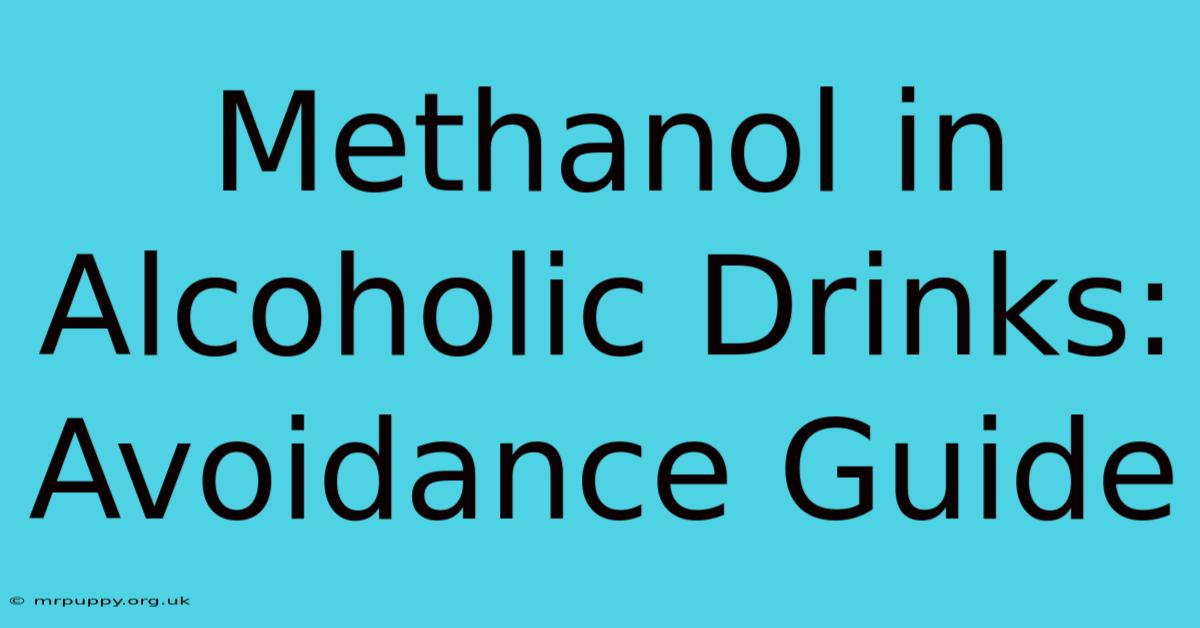Methanol in Alcoholic Drinks: A Comprehensive Avoidance Guide
Editor's Note: Concerns regarding methanol contamination in alcoholic beverages have recently resurfaced. This article provides crucial information to help consumers identify risks and make informed choices.
Why This Topic Matters
Methanol, a toxic alcohol, is a naturally occurring byproduct of fermentation. While small amounts are generally harmless, excessive levels in alcoholic drinks can lead to serious health consequences, including blindness, organ damage, and even death. This is particularly concerning with unregulated or illicitly produced spirits. Understanding the risks associated with methanol contamination and how to avoid it is crucial for anyone who consumes alcoholic beverages. This article will cover identifying high-risk drinks, understanding symptoms of methanol poisoning, and practical steps to minimize exposure.
Key Takeaways
| Point | Description |
|---|---|
| High-Risk Drinks | Illicitly produced spirits, homemade moonshine, improperly distilled alcohol. |
| Symptoms of Poisoning | Nausea, vomiting, headache, blurred vision, abdominal pain, blindness, death. |
| Safe Practices | Buy from reputable sources, check labels carefully, avoid suspiciously cheap alcohol. |
Methanol in Alcoholic Drinks
Methanol is a naturally occurring byproduct of fermentation, but reputable distilleries employ processes to remove it effectively. However, in illicitly produced or poorly distilled spirits, methanol can remain in dangerous concentrations. This is particularly relevant in countries with less stringent alcohol regulations or where homemade alcohol is common. The relevance of this topic lies in the potential for severe health risks associated with consuming methanol-contaminated alcohol.
Key Aspects of Methanol Contamination
- Source: Improper fermentation and distillation processes fail to remove methanol effectively.
- Concentration: The concentration of methanol varies greatly depending on the production method.
- Symptoms: Methanol poisoning symptoms can manifest anywhere from hours to days after consumption.
Detailed Analysis of Methanol Risk
The biggest risk comes from unregulated and homemade alcoholic beverages, particularly spirits. These lack the quality control and purification steps found in commercially produced, reputable brands. The price is a significant indicator—suspiciously cheap alcohol should raise immediate concerns. Comparisons between properly distilled vodka and a suspiciously cheap spirit demonstrate the vast difference in safety and purity. For example, a reputable vodka will undergo multiple distillation and filtration steps, effectively removing methanol and other impurities. In contrast, an illicitly produced spirit may contain dangerously high levels of methanol due to lack of these crucial steps.
Interactive Elements
Understanding Methanol Poisoning Symptoms
Methanol poisoning symptoms are often delayed, making diagnosis challenging. Early symptoms may include nausea, vomiting, and headache. More severe symptoms, which can appear hours or days later, include blurred vision, abdominal pain, respiratory distress, and even death. The severity depends on the amount of methanol ingested and individual factors. It's crucial to seek immediate medical attention if any of these symptoms appear after alcohol consumption.
Choosing Safe Alcoholic Beverages
Choosing safe alcoholic beverages involves selecting products from reputable brands and licensed distributors. Check labels carefully for information on production and origin. Avoid suspiciously cheap alcohol, as this is a major red flag for potential methanol contamination.
People Also Ask (NLP-Friendly Answers)
Q1: What is methanol?
A: Methanol is a type of alcohol, also known as methyl alcohol, that is highly toxic to humans.
Q2: Why is methanol in alcoholic drinks dangerous?
A: Methanol is metabolized into toxic substances that can cause blindness, organ damage, and even death.
Q3: How can methanol contamination be avoided?
A: Buy alcohol from reputable sources, avoid suspiciously cheap drinks, and be cautious of homemade or illicitly produced alcohol.
Q4: What are the symptoms of methanol poisoning?
A: Symptoms include nausea, vomiting, headache, blurred vision, abdominal pain, and potentially death.
Q5: What should I do if I suspect methanol poisoning?
A: Seek immediate medical attention.
Practical Tips for Avoiding Methanol Contamination
Introduction: Following these tips can significantly reduce your risk of methanol poisoning.
Tips:
- Buy from reputable brands: Stick to well-known brands with established production processes.
- Check labels: Look for information on the origin and production methods of the alcohol.
- Avoid suspiciously cheap alcohol: A significantly lower price than comparable brands should raise concerns.
- Be wary of homemade or illicit alcohol: These pose the highest risk of methanol contamination.
- Don't mix different alcohol types: Stick to one brand or type if consuming multiple alcoholic drinks.
- Drink in moderation: Excessive alcohol consumption increases the risk of complications, regardless of methanol content.
- Educate yourself: Stay informed about current risks related to alcohol safety and regulations in your area.
- Trust your instincts: If something seems off about a particular beverage, it's always best to err on the side of caution.
Summary: These tips emphasize the importance of responsible alcohol consumption and choosing beverages from trustworthy sources.
Transition: Understanding the risks and taking preventative measures is crucial for protecting your health.
Summary
Methanol contamination in alcoholic drinks represents a serious health risk, particularly with illicitly produced or poorly distilled spirits. By buying from reputable sources, avoiding suspiciously cheap alcohol, and being aware of the symptoms of methanol poisoning, consumers can significantly reduce their risk.
Closing Message
Remember, your health is paramount. Making informed choices about the alcohol you consume is a key step in safeguarding your wellbeing. Share this information with others to help spread awareness about the dangers of methanol contamination.
Call to Action (CTA)
Stay informed about alcohol safety! Subscribe to our newsletter for updates on alcohol-related health news and safety guidelines. [Link to Newsletter Signup]

